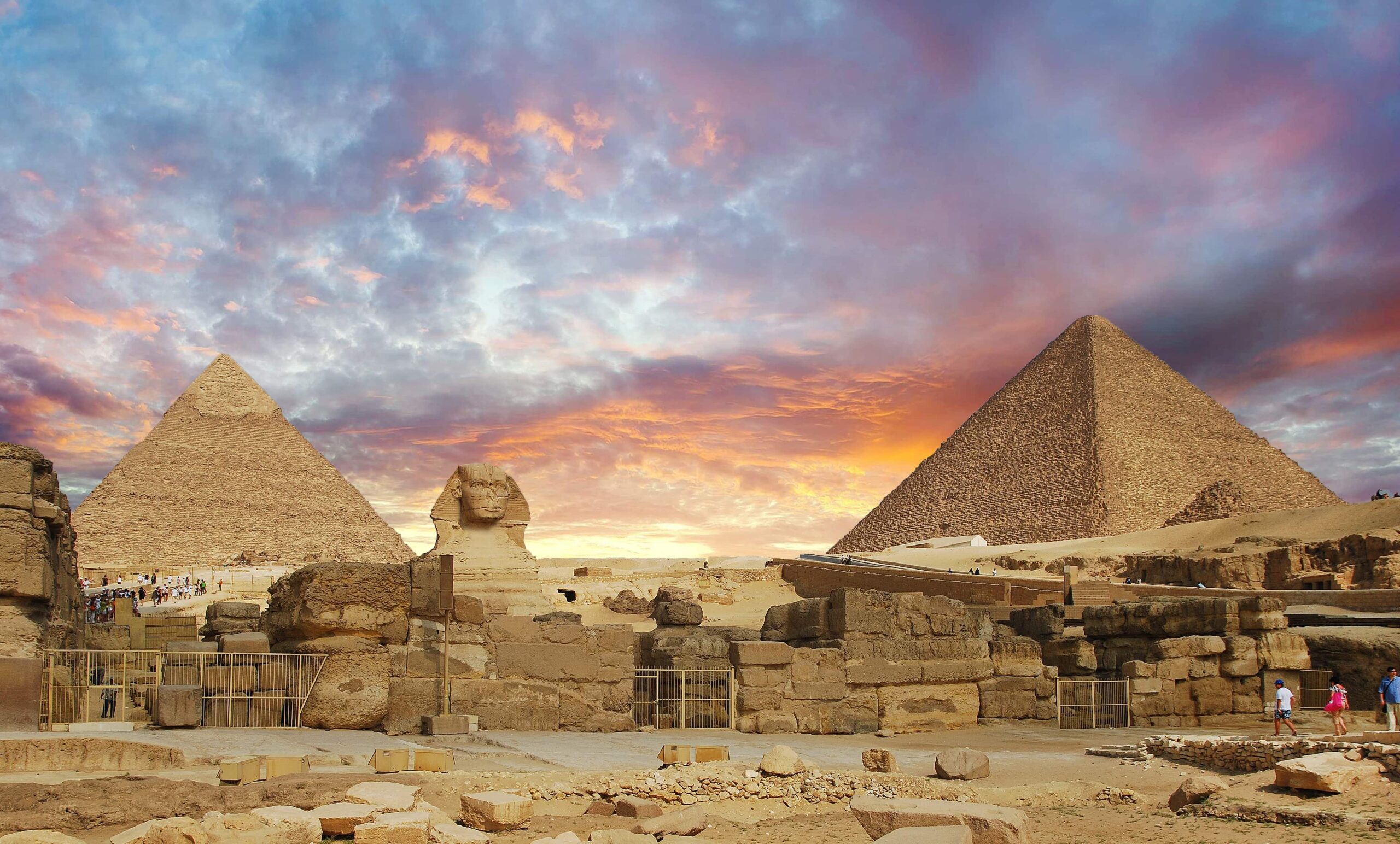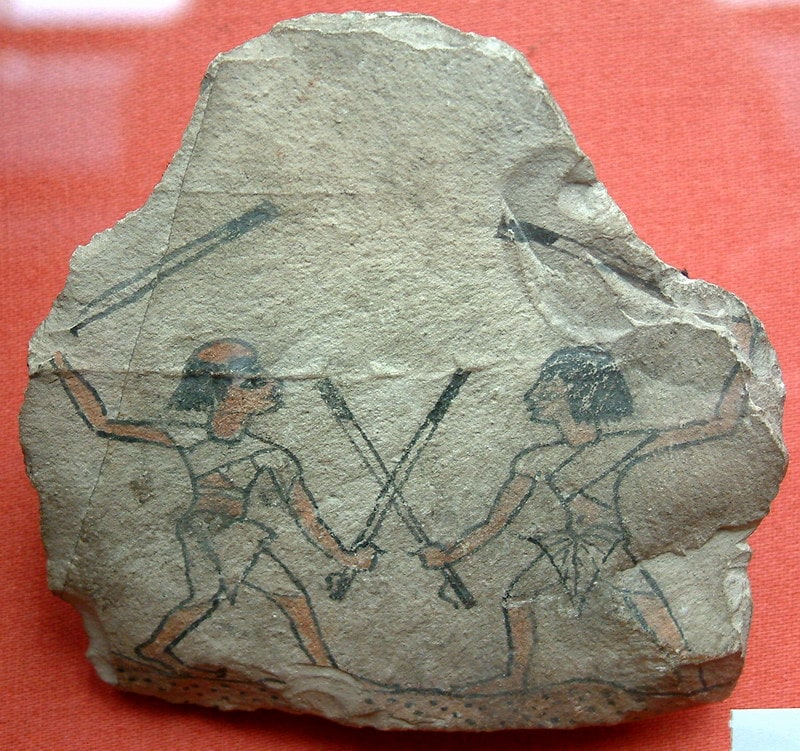Egypt is home to one of the world’s earliest civilizations. The country has seven UNESCO World Heritage sites. There’s hardly anyone in the world who doesn’t know about Egyptian pharaohs and their magnificent rule.
Ancient Egyptians were great warriors. They fought with whatever weapons were at their disposal. The Pharaohs usually fought with Khopesh, a curved sword, also known as the pharaonic sword.
At the same time, a stick fighting style started to develop in upper Egypt. It predates all classic stick-fighting techniques of the world. They called it Tahtib, which along with archery and wrestling, became the three fighting art forms taught to the soldiers in those times. These techniques allowed them to fight without spending a lot of energy.
Egypt is an exciting tourist destination for martial artists. Apart from its archeological wonders, you can have a load of fun enjoying SOHO Square’s nightlife and observing marine life at the Red Sea shores.
Pyramids of Giza and Tourist Attractions of Cairo
The mysterious Giza pyramids on the Giza plateau near Cairo are the most researched monuments in the world. According to historians, each pyramid would have taken at least 23 years to construct. They were the tallest human-made structures till the twentieth century.
Archaeologists are still confused about how Egyptians brought tons of weighted stones from places miles away from the site and lifted them to such heights. Is it a coincidence that three of these pyramids are precisely in line with the Orion belt’s three stars? Unbelievable mimicry of stars in the galaxy, isn’t it?

The mysterious allure of the Great Pyramid Of Giza earns the largest chunk of tourist revenue for Egypt. This pyramid casts no shadow at noon, and it’s located exactly at the intersection of the longest line of longitude and latitude, i.e., at the center of Earth’s landmass. It’s also perfectly aligned with the polar star, Alpha Draconis. How was all that possible to achieve without having any advanced scientific machinery, right?
Nearby in Cairo, visit the Museum of Antiquities to see various artefacts including stick fighting images obtained from Saqqara and other archeological sites in Egypt.
Not far from here is Coptic Cairo, a remnant of the bygone era of Roman Emperors. The Hanging Church is a significant landmark built by Emperor Trajan in the 3rd century BC.
The structure resembles Noah’s ark and is only a sight away from the famous Babylon Fortress.
For a memorable view of the city and the sunset, reach the Cairo Tower observation deck before dusk. You can also dine at the Sky Window or the 360 Revolving Restaurant one floor below.
Else, you can board a dinner cruise and enjoy the Cairo skyline with your dinner. However, if you wish to explore the great expense of the River Nile, go for Felucca boating, which are traditional Egyptian boats that sail downstream with the wind.
Tahtib - Egypt’s Living Artifact
As a fighting arts enthusiast, you can’t leave Cairo without getting a taste of Tahtib. Interestingly, like the manifold history of Egypt, Tahtib presents itself in various forms as well.
It’s practiced as a folk dance, a martial art, a sport, and a self-defense technique, depending on who you ask. Mutual respect and courage are central values and regardless of its form, the stick is a symbol of love and passion for peace and self-preservation, NOT of aggression. At first Tahtib was a fighting art with strict rules and regulations. Gradually, with the golden era, it began to be practiced as a leisure activity.

Source: Wikipedia
At first Tahtib was a fighting art with strict rules and regulations. Gradually, with the golden era, it began to be practiced as a leisure activity. The first evidence of Tahtib as a performing art was seen on 3500 years old archaeological sites of Luxor and Saqqara.
In that era, Tahtib was performed as a dance of chivalry and passion, and even today, it’s an integral part of ceremonies and weddings. However, during the rapid urbanization in the 20th century, Tahtib was on the edge of disappearing, until in 2016, UNESCO registered Tahtib as an intangible heritage.
Since then, it has become Egypt’s cultural identity. In 2018, under the collaboration of France and Egypt, Mallawi Dancing School performed Tahtib folk dance in Quai Branly Museum as an effort to promote it on the international level.
Tahtib as a Modern Martial Art
Adel Boulad, a Ph.D. in physics and a black belt martial artist, is credited for reforming ancient Tahtib into well-structured modern martial arts in 2014.
He spend 10 years in research with Shukry Muhammad, a Tahtib practitioner from Nubia, and wrote his famous book, Modern Tahtib: Egyptian Baton Martial and Festive Art. The Egyptian Ministry of Sports also requested Boulad to write a curriculum for modern Tahtib to be taught at Helwan University.
Modern Tahtib translates the techniques of the ancient art into well-defined forms like KATA in karate. There are manuals with instructions and pictures for newcomers to understand the art.
Taking part in Tahtib as a traditional art or dance form is a taboo for women. But, most Egyptians don’t object to girls practicing modern Tahtib as a martial art form.
There aren’t a lot of experts that can train students in modern Tahtib and pharaonic sword fighting. But, if you’re visiting Egypt, you can train with Captain Nasser El Rafaei, a young fitness enthusiast and martial artist in Cairo.
Captain Nasser is one of only two certified Modern Tahtib instructors in Egypt. His team secured the first place in the Egypt Tahtib championship in 2017. He’s skillful at Tahtib, pharaonic sword Khopesh, and other native Egyptian weapons. If you’re interested in weaponry, you might not want to miss this chance.
Egypt holds a lot of mysteries in its pyramids, temples, and traditions. There’s a lot to explore and a lot to learn in the ancient cities of Giza and Cairo. So, don’t forget to enjoy Tahtib and pick up a move or two to brush up your fighting skills and surprise your peers on your return.
